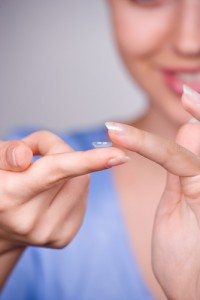 While the brilliant Leonardo da Vinci is often credited as the first person to come up with the contact lens way back in 1508 and the first actual contact lens made out of glass was created in 1887, the modern era of contact lenses truly began in 1939 with the development of the first plastic contact lens.
While the brilliant Leonardo da Vinci is often credited as the first person to come up with the contact lens way back in 1508 and the first actual contact lens made out of glass was created in 1887, the modern era of contact lenses truly began in 1939 with the development of the first plastic contact lens.
Plastic contacts were developed in the 1950s by a team of scientists who were actually looking to create a material that was suitable for eye implants. Met with scorn, the inventors made the first batch of over 5,000 contacts in their kitchen before their ideas were accepted by the scientific community.
Those first hard lenses, and the eventual creation of soft lenses, were often uncomfortable and could only be worn for short periods of time. Today, however, contact lens technology is doing amazing things to help your vision.
Contact Materials
Today’s contacts are made up of a variety of plastic polymers that have the ability to absorb water while retaining their shape and durability. They also can transmit oxygen through their surface to your eye, which is crucial for retaining eye health. These hydrophilic qualities are evident in plastics like poly hydroxyethyl methacrylate, which is what most manufacturers use to make soft contacts.
Recently, an advanced variety of polymer called silicone hydrogel was developed to allow for even more oxygen transmission and thinner lenses. This means your contacts would give you better vision with less discomfort. These new plastics let almost 100 percent of available oxygen to get to the surface of your eyes while retaining their own moisture, which helps keep your eyes from drying out.
Making Process
The process to make contact lenses is done in one of two ways: lathe cutting or injection molding, explains Made How. In the first method, non-hydrated discs of the material are mounted on spinning shafts and are precisely cut by computer controlled cutting tools. After both the front and back are shaped to exact measurements, the contact is soaked in a solution to hydrate and soften it. The injection molding method consists of heating the contact material to a molten state and injecting it into molds under high pressure. The lens is then quickly cooled and polished before being hydrated and softened.
While longer and more intensive, the lathe cutting method is considered a more effective way of creating lenses. And, with today’s technology and robotics, it is almost completely automated. However, most disposable contacts are made by the injection molding process because it is considerably more cost efficient.
A Look Into the Future
The technology being incorporated into contacts is more and more amazing every day. For instance, Google is creating contacts with smart lens technology. These lenses will have sensors that can monitor glucose levels in your eye fluids and other statistics that can be transmitted to devices. This aims to help diabetic patients and doctors. Additionally, Cooper Vision is creating multi-focal lenses that can help people see at various distances. These are different than bi-focal glasses because they have zones that are situated precisely so that no matter where you are looking, you have the best vision available.
With the wide variety of lenses and options available to you, make sure you do your research when looking to get contacts. Companies like Vision Direct can provide you with the most up-to-date and technologically advanced lenses. Whatever you decide, your vision is important, so make sure you take the time and energy to get the best option for you.

